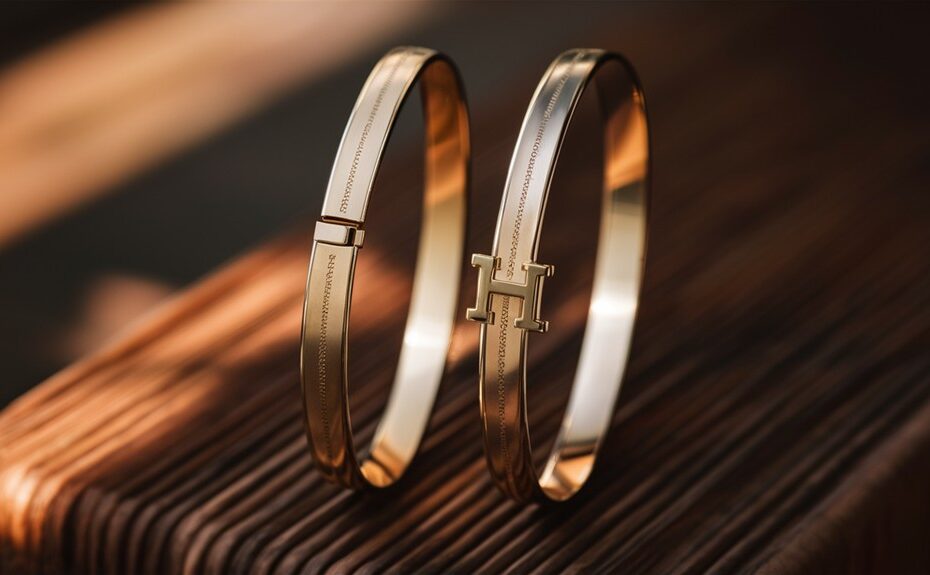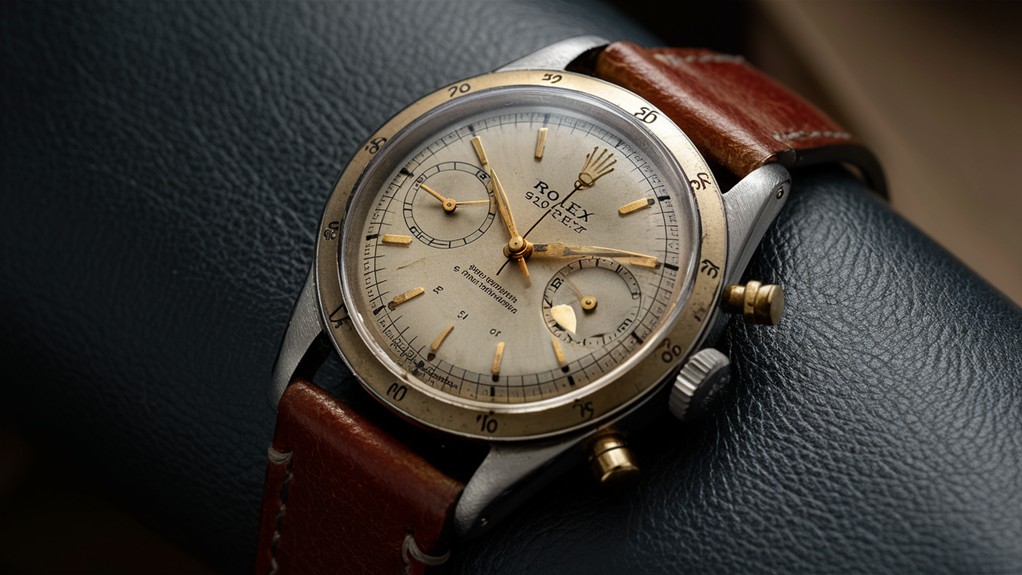You're about to enter the intricate world of Hermès thin bangle authentication, where the smallest details can make the biggest difference. As you start your expedition to distinguish genuine H bracelets from clever counterfeits, you'll need to sharpen your eye for the subtleties that set authentic pieces apart. From the iconic orange packaging to the precise markings and craftsmanship, each element plays a vital role in verifying a bracelet's authenticity. But don't be fooled—even experienced collectors can be stumped by high-quality fakes. Are you ready to uncover the secrets that separate the real from the replicas? And the challenge doesn’t stop there. In addition to mastering the art of Hermès thin bangle authentication, collectors also need to be knowledgeable in verifying the legitimacy of other luxury items, such as ametrine gem authenticity. The world of luxury goods is a complex and ever-evolving landscape, but with patience, diligence, and a keen eye for detail, you can navigate it successfully. So, are you prepared to take on the task of discerning between the authentic and the counterfeit in the world of luxury accessories and gemstones? As you delve deeper into the realm of luxury authentication, be prepared to learn about the intricate cartier love bracelet authenticity markings that set the genuine pieces apart from the fakes. These markings are a crucial element in determining the legitimacy of Cartier love bracelets and require careful examination. With dedication and continued education, you’ll develop the expertise needed to navigate the world of luxury goods with confidence and precision.
Our Highlighted Points
- Authentic Hermès H bracelets have a smooth, oval shape for ergonomic fit, while counterfeits often appear circular.
- Genuine enamel features rounded edges and consistent color; fakes may have sharp edges or uneven coloration.
- Real Hermès bangles have substantial weight due to quality materials; counterfeits typically feel lighter.
- Authentic closures use flathead or star-shaped screws and operate smoothly; fakes may have inferior fasteners or stiff hinges.
- Genuine Hermès packaging has a distinct Pantone 165C orange hue and pebbled texture; counterfeits use generic orange and smooth textures.
Packaging Analysis

The packaging of a Hermès thin bangle can be a telltale sign of its authenticity. When examining the box, pay close attention to the following key indicators:
- Color: Genuine Hermès packaging features a distinct orange hue matching Pantone 165C. Counterfeit boxes often use a generic orange shade, lacking the precise color match.
- Logo: Authentic boxes display a dark chocolate brown logo that's straight and centered. Fake packaging may have misaligned or incorrect logos, immediately raising suspicion.
- Texture: Run your fingers over the box's surface. Genuine Hermès boxes have a softly pebbled texture, while counterfeits typically feel smooth.
- Print Quality: Scrutinize the comprehensive print clarity on the packaging. Authentic Hermès boxes exhibit superior print quality compared to their fake counterparts.
- Absence of Authenticity Cards: Contrary to popular belief, genuine Hermès packaging doesn't include authenticity cards. The presence of such cards should raise red flags.
Origin and Production Markings
Moving from the packaging to the bracelet itself, examining origin and production markings is key in authenticating a Hermès thin bangle.
When assessing the origin and production markings, consider the following:
- Pre-2010 enamel bracelets: Look for "Made in Austria"
- Post-2010 enamel bracelets: Should be marked "Made in France"
Be cautious of vintage Hermès items labeled "Made in France," as this could indicate a counterfeit.
Authentic Hermès bracelets feature specific date codes corresponding to their production era, guaranteeing traceability. The absence of proper production markings or incorrect labeling is a strong indicator of a fake Hermès bracelet.
To authenticate your thin bangle:
- Locate the origin marking
- Verify it matches the expected production location for its era
- Check for the presence of a date code
- Confirm the date code aligns with the claimed production period
Dimensional Accuracy
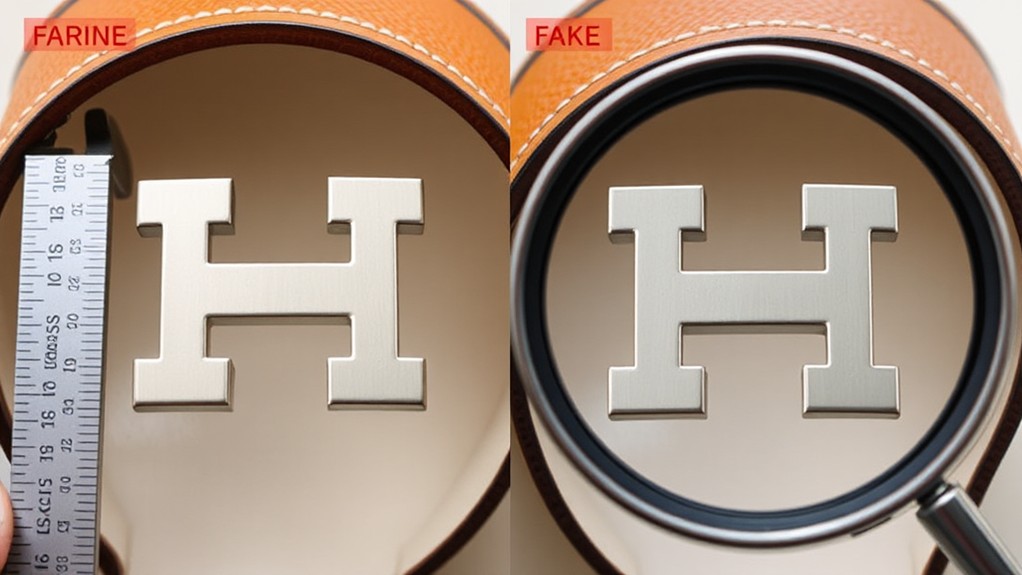
As you investigate the dimensional accuracy of a Hermès thin bangle, you'll find that precise measurements are crucial for authentication. The Clic Clac bracelet, for instance, should adhere to specific dimensions that can be verified against the official Hermès website.
When examining a potential authentic piece, consider the following:
- Size consistency: Genuine bangles maintain uniform dimensions across all pieces, while counterfeits may vary.
- Weight: Authentic Hermès bangles have a substantial feel because of high-quality materials; fakes often feel noticeably lighter.
- Shape: Look for an oval design in genuine pieces, which guarantees a comfortable fit. Counterfeit versions may appear more circular and less ergonomic.
- Thickness and width: Compare these measurements carefully, as discrepancies can indicate a fake.
To authenticate your Hermès thin bangle:
- Measure the inner diameter, width, and thickness with precision tools.
- Compare your measurements to official Hermès specifications.
- Assess the weight and complete feel of the bangle.
- Examine the shape for proper ergonomics.
Weight Considerations
In relation to authenticating a Hermès thin bangle, weight plays a crucial role. Genuine Hermès Clic Clac H bracelets are designed with a noticeable heft because of their solid metal construction, contributing to their general quality and durability. When assessing the authenticity of these bracelets, you should pay close attention to their weight.
To determine if your Hermès bracelet is authentic, consider the following:
- Compare the weight to official Hermès specifications
- Check for consistency across multiple models
- Assess the general feel in your hand
Counterfeit bracelets often feel markedly lighter because of the use of cheaper materials like plastic or resin. If you notice a bracelet feels uncharacteristically light or flimsy, it's a strong indication that it may be a fake.
When comparing multiple bracelets, authentic pieces shouldn't vary greatly in weight. Consistency is key in Hermès manufacturing. If you're unsure about the weight, consider using a precision scale to measure and compare against known authentic pieces.
Enamel Quality Inspection
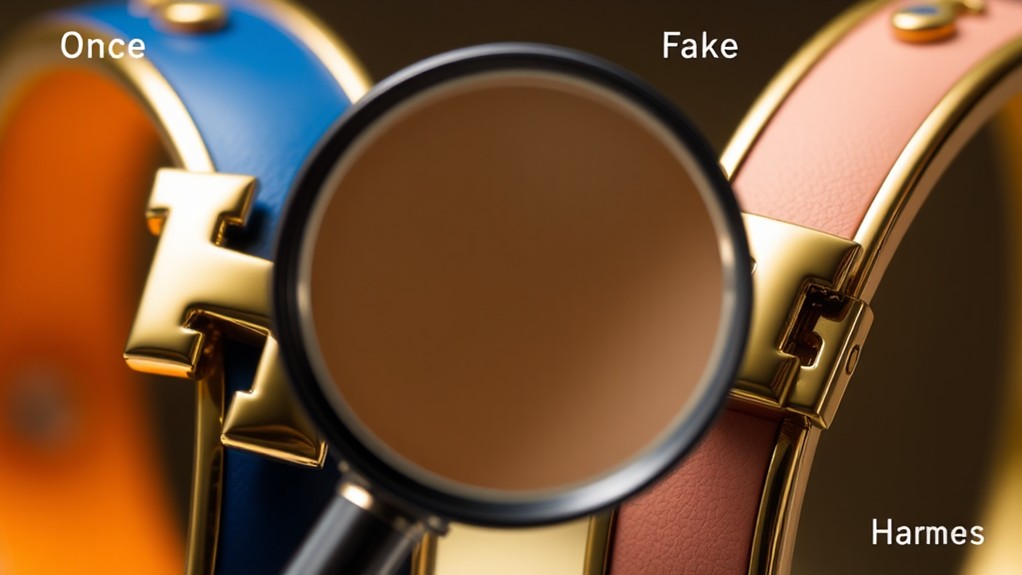
The enamel on a Hermès Clic Clac H bracelet is a telltale sign of authenticity. When inspecting the enamel, focus on its quality and appearance. Genuine bracelets feature solid pieces of enamel that are smoothly set into the metal frame, with slightly rounded edges indicating high-quality craftsmanship. You'll notice consistent color saturation throughout authentic enamel, while counterfeit versions may exhibit color inconsistencies or fading.
| Authentic Enamel | Counterfeit Enamel |
|---|---|
| Smooth, rounded edges | Sharp or uneven edges |
| Consistent color | Color inconsistencies |
| No visible seams | Visible seams or joints |
| Scratch-resistant | Prone to scratches |
Examine the enamel closely for any visible seams or joints, as these can indicate a counterfeit product. Authentic Hermès enamel is scratch-resistant and feels substantial, unlike counterfeit materials that may be lighter and made from inferior plastics or resins. Run your finger along the enamel's surface; it should feel smooth and solid. If you notice any roughness or unevenness, it's likely a fake. Remember, high-quality enamel is a hallmark of genuine Hermès bracelets, so pay close attention to these details during your authentication process.
Closure Mechanism Verification
When authenticating a Hermès H bracelet, verifying the closure mechanism is crucial. The authentic closure should operate with slight tension, providing a secure fit without being too loose or tight.
As you examine the bracelet, pay close attention to the following details:
- Screws: Genuine H bracelets use flathead or star-shaped screws. Counterfeit versions often employ inferior fasteners that may lack proper alignment.
- Hinge movement: The hinge of an authentic bracelet should move smoothly without resistance, indicating quality craftsmanship. Fakes often feel stiff or wobble.
- Clasp security: When closed, the clasp on a real Hermès H bracelet should feel sturdy and secure, with no gaps that could suggest poor manufacturing.
- Alignment: Inspect the alignment of the clasp and screws carefully. Misalignment or uneven placement may indicate a counterfeit item.
To thoroughly assess the closure mechanism:
- Open and close the bracelet several times
- Check for smooth operation and proper tension
- Examine the screws for correct type and alignment
- Verify that the clasp closes securely without gaps
Date Code Identification
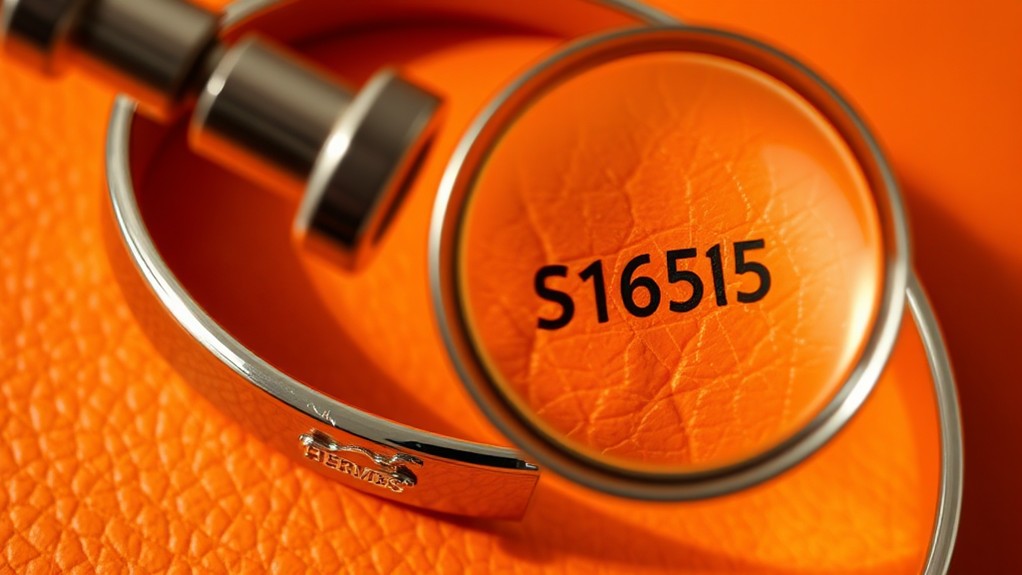
After examining the closure mechanism, you'll want to turn your attention to the date code. Hermès bracelets feature specific dating codes that allow you to identify the creation year of the piece. You'll find this code under the "Hermès" engraving on the inside of the bracelet.
For pieces made between 1946 and 2015, a single capital letter indicates the year. It's essential to verify this aligns with the correct production era. Here's a quick reference table for some recent years:
| Year | Code | Production Location |
|---|---|---|
| 2007 | K | Made in Austria |
| 2010 | N | Made in France |
| 2013 | Q | Made in France |
| 2015 | S | Made in France |
| 2017 | A | Made in France |
Craftsmanship Evaluation
Beyond date codes, evaluating the craftsmanship of a Hermès Thin Bangle is vital for authentication.
When examining a genuine piece, you'll notice an ergonomic oval shape that fits comfortably on the wrist, unlike counterfeit versions that often appear round. Pay close attention to the construction of metal and enamel components, which are crafted separately in authentic bangles. Genuine pieces feature rounded enamel ends, while fakes may display sharp edges or uneven finishes.
The clasp is another important element to assess. Authentic Hermès bangles have a smooth-operating clasp with slight tension, whereas counterfeit clasps are typically wider and may feel loose or overly tight.
Examine the hardware and O rings closely; genuine pieces have well-affixed components with freely spinning O rings, contrasting with the rigid O rings found in fake items.
Material Composition Assessment
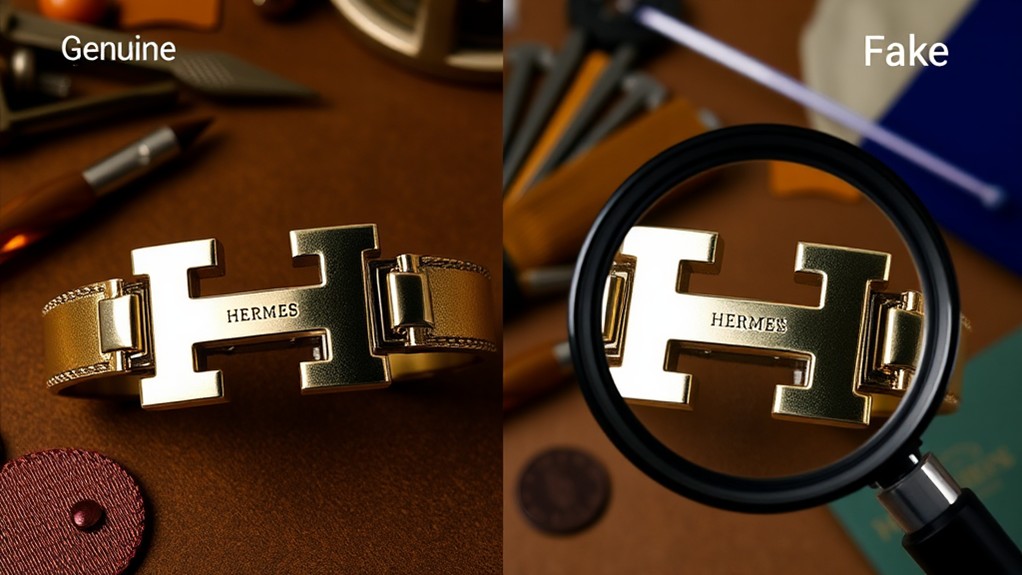
The material composition of a Hermès Thin Bangle is a crucial factor in determining its authenticity. When conducting a material composition assessment, you'll find that genuine bracelets are crafted from solid scratch-resistant enamel, while counterfeits often use inferior materials like plastic or resin. The metal components in authentic pieces are made separately from the enamel, resulting in smooth, rounded edges. In contrast, fake bracelets may have sharp or uneven edges.
| Feature | Authentic Hermès | Counterfeit |
|---|---|---|
| Enamel | Solid, scratch-resistant | Plastic or resin |
| Metal | Gold or palladium-plated | Inferior alloys |
| Weight | Noticeably heavier | Lightweight |
| Color | Consistent saturation | Possible discrepancies |
High-quality craftsmanship is evident in the general durability and feel of genuine Hermès bracelets. The enamel displays consistent color saturation without visible seams, while counterfeits may exhibit color discrepancies or uneven finishes. The metal used in authentic pieces is either gold-plated or palladium-plated, contributing to a substantial weight that's lacking in fakes. By carefully examining these material aspects, you can more accurately distinguish between genuine and counterfeit Hermès Thin Bangles.
Frequently Asked Questions
Does the Hermes H Bracelet Tarnish?
Your Hermès H Bracelet shouldn't tarnish easily if it's genuine. It's made with high-quality plating that resists discoloration. However, you'll want to care for it properly by cleaning gently and storing it safely to maintain its luster.
Is Hermès Bangle Real Gold?
Your Hermès bangle isn't typically solid gold. It's usually gold-plated, often with 18K gold over a base metal. If you're unsure, you can have it professionally assessed to verify its metal composition and authenticity.
How Do You Wear a Hermes Clic H Bracelet?
You'll want to wear your Hermès Clic H bracelet snugly on your wrist, with the "H" clasp facing outward. It's stylish to layer it with other bracelets, but make sure you've chosen the right size for comfort.
Where Are Hermès Bracelets Made?
Hermès bracelets are made in different locations depending on their production date. If you're checking authenticity, you'll find pre-2010 pieces marked "Made in Austria," while those made after 2010 say "Made in France." It's essential for verifying genuineness.
